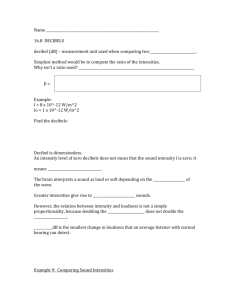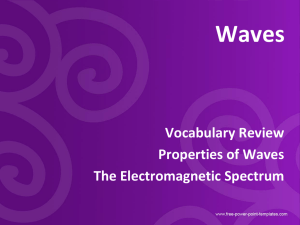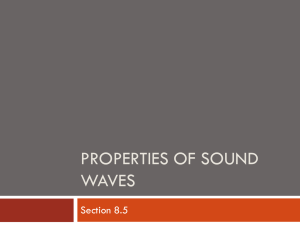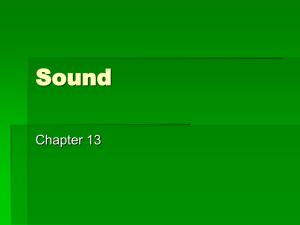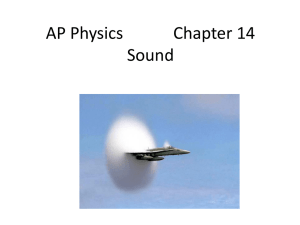Document
advertisement
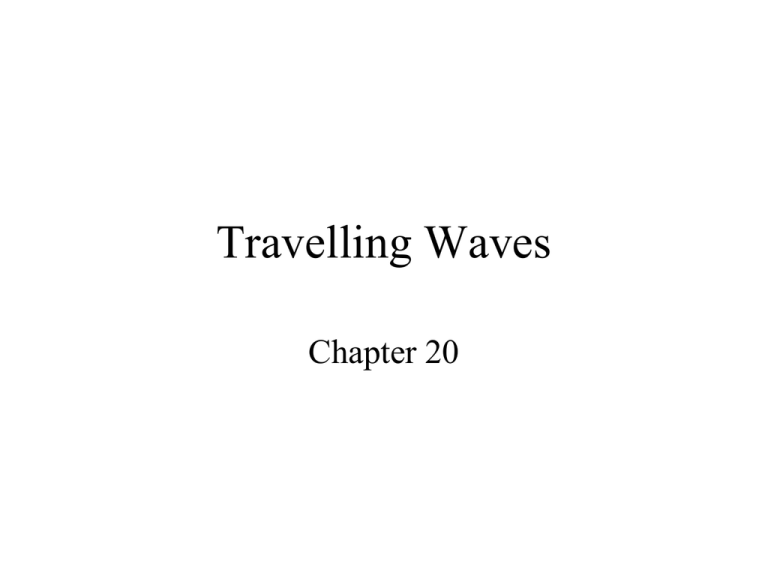
Travelling Waves Chapter 20 Waves • Mechanical Waves – Require a medium – Sound, water, strings • Electromagnetic Waves – Can travel through a vacuum – Radio to gamma • Matter Waves – Electrons and atoms Transverse and Longitudinal • Transverse – Up and down – Displacement is perpendicular to medium – Strings, water, electromagnetic • Longitudinal – pulses – Displacement – Sound Formula T = 1/f v=lf v = speed (m/s) l = wavelength (m) f = frequency (cycles/s or Hz) Example 1 A sound waves travels at 343 m/s and has a frequency of 17,000 Hz a. Convert the frequency to kiloHertz b. Calculate the wavelength Example 2 A photon has a wavelength of 5.50 X 10-7 m and a frequency of 5.45 X 1014 Hz. a. Calculate the speed of light b. Calculate the period Speed of Sound • Varies with the medium • v = \/ B/r • Solids and liquids – Less compressible – Higher Bulk modulus – Move faster than in air Material Air (20oC) Air (0oC) Water Saltwater Iron/Steel Speed of Sound (m/s) 343 331 1440 1560 ~5000 Speed of Sound: Temperature • • • • Speed increases with temperature (oC) v ≈ (331 + 0.60T) m/s What is the speed of sound at 20oC? What is the speed of sound at 2oC? Speed of Sound: Example 1 How many seconds will it take the sound of a lightening strike to travel 1 mile (1.6 km) if the speed of sound is 340 m/s? v = d/t t = d/v t = 1600 m/(340 m/s) ≈ 5 seconds (count five seconds for each mile) Pitch • Pitch – frequency (not loudness) • Audible range 20 Hz – 20,000 Hz Infrasonic Audible Ultrasonic 20 Hz 20,000 Hz Earthquakes 50,000 Hz (dogs) Thunder 100,000Hz(bats) Volcanoes Machinery Intensity • Intensity = Loudness • Louder = More pressure • Decibel (dB) – named for Alexander Graham Bell • Logarithmic scale • Intensity level =b b = 10 log I Io Io = 1.0 X 10-12 W/m2 = lowest audible intensity Example • Rustle of leaves = 10 dB • Whisper = 20 dB • Whisper is 10 times as intense Example • Police Siren = 100 dB • Rock Concert = 120 dB Decibels: Example 1 How many decibels is a sound whose intensity is 1.0 X 10-10 W/m2? b = 10 log I Io = 10 log (1.0 X 10-10 W/m2) (1.0 X 10-12 W/m2) b = 10 log (100) = 20 dB Decibels: Example 2 What is the intensity of a conversation at 65 dB b = 10 log I Io b = log I 10 Io 65 = log I 10 Io 6.5 = log I Io 6.5 = log I – log Io log I = 6.5 + log Io log I = 6.5 + log (1.0 X 10-12 W/m2) log I = 6.5 – 12 = -5.5 I = 10-5.5 = 3.16 X 10-6 Decibels: Example 3 What is the intensity of a car radio played at 106 dB? (Ans: 1.15 X 10-11 W/m2) Decibels: Example 4 A blender produces an intensity level of 83dB. Calculate the decibels if a second blender is turned on (doubles the intensity, Io = 1.0 X 10-12 W/m2). Intensity and Distance • Intensity = Power/area • Inverse-squared radius • Intensity decreases proportionally as you move away from a sound (area of a ripple increases as you move out) Ia1 r2 or I1r12 = I2r22 Distance: Example 1 The intensity level of a jet engine at 30 m is 140 dB. What is the intensity level at 300 m? 140 dB = 10 log I/Io 14 = log I/Io 14 = log I – log Io log I = 14 + log Io = 2 I = 100 W/m2 I = 100 W/m2 I1r12 = I2r22 I2 = I1r12/r22 I2 = (100 W/m2)(30 m)2/(300 m)2 I2 = 120 dB Distance: Example 2 If a particular English teacher talks at 80 dB when she is 10 m away, how far would you have to walk to reduce the sound to 40 dB? (Hint: Find the raw intensity of each dB first). ANS: 1000 m Doppler Effect •Frequency of sound changes with movement •Moving towards you = frequency increases (higher pitch) •Moving away = frequency decreases (lower frequency) Moving Source Source moving towards stationary observer f’ = f 1 - vs v Source moving away from stationary observer f’ = f 1 + vs v Moving Observer Observer moving towards stationary source f’ = 1 + vo f v Observer moving away from stationary source f’ = 1 - vo f v Doppler Effect and the Universe • Universe is expanding • Evidence (Hubble’s Law) – Only a few nearby galaxies are blueshifted – Most are red-shifted • Universe will probably expand forever Doppler: Example 1 A police siren has a frequency of 1600 Hz. What is the frequency as it moves toward you at 25.0 m/s? f’ = f 1 - vs v f’ = 1600 Hz = 1600 Hz = 1726 Hz [1 – (25/343)] 0.927 What will be the frequency as it moves away from you? f’ = f 1 + vs v f’ = 1600 Hz = 1600 Hz = 1491 Hz [1 + (25/343)] 1.07 Doppler: Example 2 A child runs towards a stationary ice cream truck. The child runs at 3.50 m/s and the truck’s music is about 5000 Hz. What frequency will the child hear? f’ = 1 + vo f v f’ = 1 + vo f v f’ = [1+(3.50/343)]5000 Hz f’ = (1.01)(5000 Hz) = 5051 Hz Electromagnetic (EM) Waves • Can travel through space • Radio, Microwaves, IR, Light, UV, X-rays, Gamma Rays • All on the electromagnetic spectrum • James Clerk Maxwell EM Wave • Sinusoidal • E and B are perpendicular to one another • E and B are in phase • Accelerating electric charges produce electromagnetic waves Wave Properties • First man-made EM waves detected by Hertz (8 years of Maxwell’s death) l = wavelength (meters) f = frequency (cycles/s or Hertz) c=fl (in a vacuum, c = 3.00 X 108 m/s) Light 3. Electromagnetic Spectrum Radio Radar Micro IR Visible Light UV Xrays Gamma • Visible light • 4 X 10-7 m to 7X 10-7 m (400 to 700 nm) • Electrons – Radio – running electrons up and down an antenna – Electrons moving within atoms and molecules – X-rays - Electrons are rapidly decellerated by striking metal • Gamma Rays – Nuclear decay Waves: Ex 1 Calculate the wavelength of a 60 Hz EM wave fl=c l = c/f l = (3.0 X 108 m/s)/60 s-1 = 5 X 106 m What range of the spectrum is this? Waves: Ex 2 Calculate the wavelength of a 93.3 MHz FM radio station fl=c l = c/f l = (3.0 X 108 m/s)/(93.3 X 106 s-1) = 3.22 m Waves: Ex 3 Calculate the frequency of 500 nm blue light. fl=c f = c/ l f = (3.0 X 108 m/s)/500 X 10-9 m = 6 X 1014 Hz Waves: Ex 4 When you speak to a telephone to someone 4000 km away, how long does it take the sound to travel? v = d/t t = d/v T = (4000 X 103 m)/(3 X 108 m/s) = 1.3 X10-2 s Speed is less because of wires Index of Refraction • • • • Light slows when passing through a substance Must be absorbed and re-emitted Eyes slow light by ~30% Bose-Einstein condensate (50 nanokelvins) v = 38 mph n=c v v = speed in material n = index of refraction Refraction: Ex 1 Calculate the speed of light in water n=c v v = c/n v = (3.00 X 108 m/s)(1.33) = 2.26 X 108 m/s
